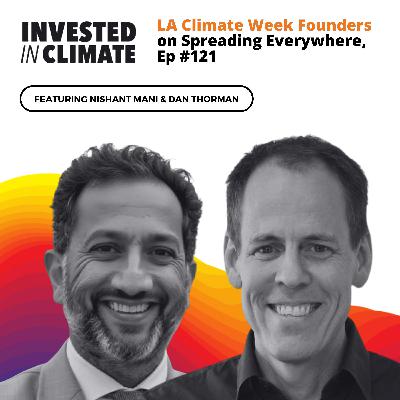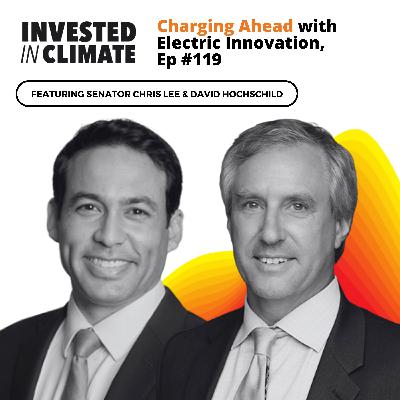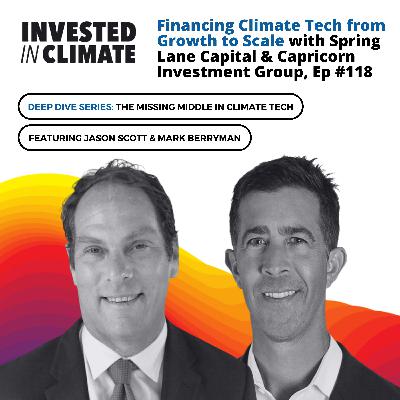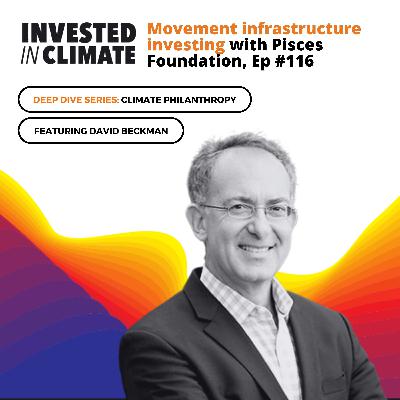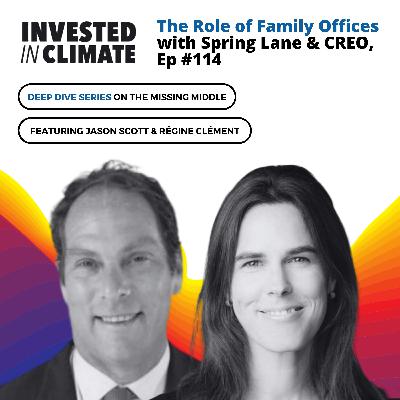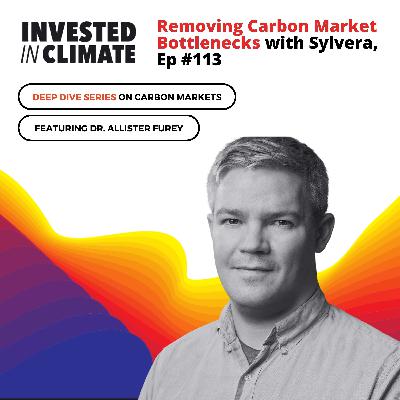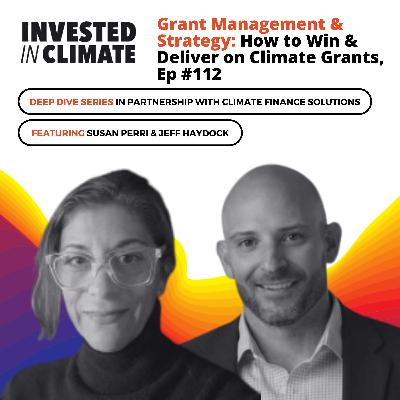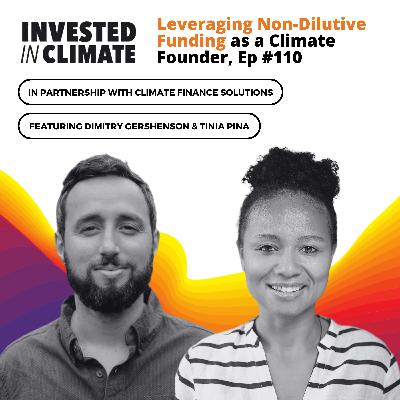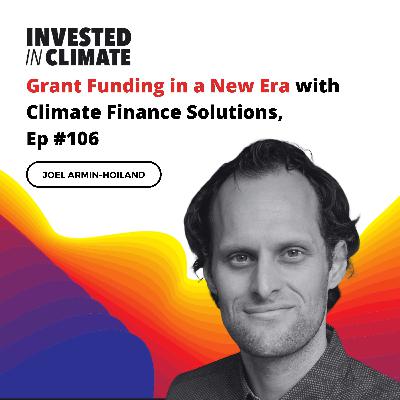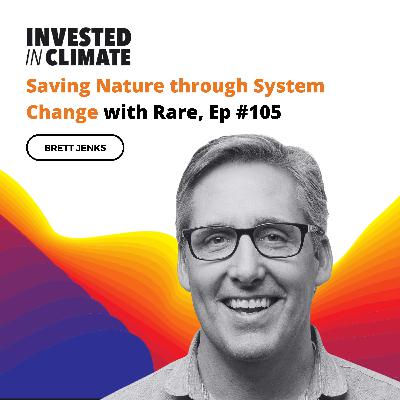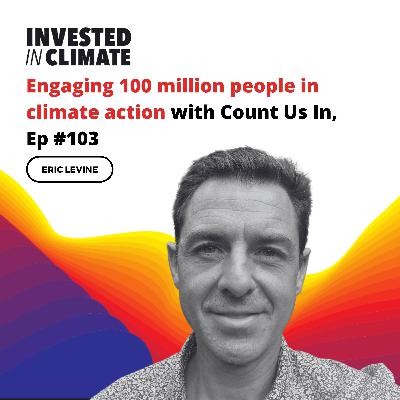Discover Invested In Climate
Invested In Climate

Invested In Climate
Author: Jason Rissman
Subscribed: 19Played: 144Subscribe
Share
© Copyright 2025 Jason Rissman
Description
Invested in Climate hosts conversations with leading thinkers to help our listeners do more to address the climate crisis through their Work, Investments, Learning, Lifestyle and Activism.
People everywhere, communities, governments and all sectors of the economy are mobilizing to address climate change. The scale of this global action is unprecedented. Never before have so many people dedicated so much energy, creativity and capital to addressing a shared, global threat. Will it be enough? What else is needed? And, most importantly, what can you do?
We all have a part to play, so let’s go.
People everywhere, communities, governments and all sectors of the economy are mobilizing to address climate change. The scale of this global action is unprecedented. Never before have so many people dedicated so much energy, creativity and capital to addressing a shared, global threat. Will it be enough? What else is needed? And, most importantly, what can you do?
We all have a part to play, so let’s go.
124 Episodes
Reverse
The vast majority of my interviews have focused on innovations, investing and advocacy related to climate mitigation – that is, what we can do to cut greenhouse gases and minimize the rise in global temperatures. What we do or don’t do now, will have lasting consequences and it is climate mitigation that is driving the transformation of the global economy. So it’s not surprising that mitigation dominates climate investing. Adaptation and resilience, meanwhile, focus not on limiting or reversing climate change but rather on improving quality of life in a warmer world. Adaptation ventures receive only a small fraction of climate investments, but rising temperatures are creating tremendous demand for a new category of products. In a joint report by Boston Consulting Group (BCG) and Temasek, it’s estimated that between $500 million and $1.3 trillion could be spent annually by 2030 on technologies that help people adapt to a changed climate. That’s the opportunity Darren Clifford is targeting with a new fund called Adapt[us]. Darren has worked for two decades on new markets as a founder, consultant at McKinsey & Co, and as an angel investor, and I found his perspective on the climate adaptation market to be packed with nuance and insight. We spoke about his background, three different categories of adaptation tech, the unique challenges they face, how they’ll make the future more livable, and much more. On today’s episode, we cover:[02:45] Darren’s Background & Career Journey[06:39] Why Focus on Climate Adaptation?[08:07] Insights from Angel Investing & Supporting Founders[12:14] Why Adaptation is Underfunded; Adapt[us] Fund Overview[16:19] Challenges in Scaling Adaptation Solutions[17:31] Adapt[us] Fund: Focus & Stage, Why For-Profit[18:53] Measuring Impact & Third-Party Well-being Validation[23:10] Market Segmentation: Resilience, Repair & Recovery, Demand Adaptation[25:38] Market Size and Investment Allocation[27:50] Business Model Challenges for Adaptation Startups[30:23] Concrete Examples of Target Companies [32:59] Adapt[us] Venture Building Approach & Founder Support[36:42] The Venture Builder/Capital Model: Criteria & Structure[38:27] Norwegian Talent & Global Competitive Advantages[41:03] Building a Movement, Not Just a Fund[42:06] Short-Term Goals for Adapt[us] & Team Building[44:41] Closing RemarksResources MentionedAdapt[us]BCG x Temasek Report: The Private Equity Opportunity in Climate Adaptation and ResilienceToronto Climate WeekGIC Report: Sizing the Inevitable Investment Opportunity: Climate AdaptationWRI Study: Strengthening the Investment Case for Climate Adaptation: A Triple Dividend ApproachConnect with usa...
In case you missed it, last week was NY Climate Week. There were well over 1,000 events — from summits with CEO and heads of state, to film screenings, concerts, parties, boat cruises, pitch sessions, hackathons and much more. I tried to sum up my experience at New York climate week in a special episode two years ago. This year, of course, the context was different with a US administration no longer interested in climate, and a lot of green hushing, hand wringing and new language that aims to be less politicizing.To me, one of the most interesting things about NY Climate Week is that it's not the only one. Climate weeks are spreading. San Francisco, Los Angeles, Washington DC, San Diego, Shanghai, Bangkok, Panama City all have climate weeks. There might be dozens more in the works. No city on the planet is immune from the impact of climate, and most cities have thriving ecosystems of organizations, innovators, investors, policymakers, researchers and more working to advance climate solutions and adapt to a changing planet. In this conversation I’m joined by Nishant Mani and Dan Thorman, co-founders of the LA Climate Week. Nishant and Dan saw a need to bring together their community. They volunteered to lead and have built LA Climate Week into a successful example that people anywhere can follow to create their own week of solidarity, learning and action. We talk about their backgrounds, the founding story of LA Climate Week, the impact of the LA wildfires on last year’s event, lessons they’ve learned and much more. So whether or not you were in New York last week, I hope you’ll enjoy this conversation and consider how you can help your local climate community wherever you are. On today’s episode, we cover:1:22 – Recap of New York Climate Week & Spread of Climate Weeks3:43 – Nishant’s Personal & Professional Background6:19 – Dan’s Personal & Professional Background 10:16 – The Origin Story of LA Climate Week14:40 – The Role of Entertainment & Culture in LA Climate Week17:08 – Entertainment Industry’s Role in Climate Movement18:33 – Impact of Wildfires on LA Climate Week24:47 – The Broader Role of Climate Weeks & Local Collaboration27:51 – Lessons Learned from Organizing LA Climate Week32:20 – Evolving the Structure and Infrastructure Involvement33:02 – Measuring Success and Growth of LA Climate Week36:44 – Community Engagement & Accessibility39:32 – Aspirations for the Future: Magic Wand Scenario42:21 – Future Planning and Event Announcement44:14 – Closing Remarks and Call to ActionResources MentionedLA Climate WeekClimate CapitalTerra.doReunionCollidescope FoundationJane Goodall InstituteConnect with usNishant ManiDan ThormanJason RissmanKeep...
Climate tech companies face a range of structural challenges to securing the mid stage investment needed to scale their solutions. The lack of capital at this stage prevents many viable, potentially transformative technologies from going mainstream and eliminating gigatons of emissions. That’s why we’ve been running a series of episodes on the Missing Middle in Climate Tech in partnership with Spring Lane Capital. If you haven’t heard our previous three episodes in this series, check them out at investedinclimate.com, and if you have ideas of other topics that warrant a Deep Dive series please reach out through the contact form on our website. For the fourth episode in our series, I’m joined by Spring Lane Capital Co-Founder and Partner Rob Day who guest hosts the conversation with Blackhorn Ventures Managing Partner Melissa Cheong. On today’s episode, we cover:2:23 – Introducing Blackhorn Ventures & Melissa Chong3:31 – Melissa’s Path to Venture Capital & Impact Investing8:44 – Surprises & Learnings in Venture Capital10:13 – Overview of Blackhorn Ventures’ Investment Focus & Strategy13:55 – Addressing the Missing Middle: Digital vs. Hardware Solutions17:18 – Leveraging Accepted Hardware & Digital Solutions19:09 – The Role of Vertical Data Pools in Construction and Energy21:03 – AI, Utilities, and the Urgency for Digital Solutions25:10 – Building Resilience & Anti-Fragile Mindsets in Climate Tech28:14 – Exploring New Financing Instruments & Insurance32:21 – Portfolio Example: Formic – Robotics as a Service36:37 – Portfolio Example: King Energy – Solar for Multi-Tenant Properties38:55 – Lessons from Community Solar & Smart Billing40:00 – Takeaways: The Evolving Role of Venture Capital in Climate Impact43:24 – Closing RemarksResources MentionedSpring Lane CapitalBlackhorn VenturesFormicKing EnergyConnect with usRob DayMelissa CheongJason RissmanKeep up with Invested In ClimateSign up for our NewsletterLinkedIn
I’ll admit it’s not often these days that I’m talking to climate leaders, particularly those working on policy, who say it’s an exciting time. This conversation was like a breath of fresh air. It’s not getting the headlines it deserves, but innovation is literally electrifying our country. Sector by sector, state by state, our economy is being transformed by electric technology replacing outdated fossil fuel applications.To elevate and accelerate this wave of innovation, Hawaii State Senator Chris Lee and California Energy Commission Chair David Hochschild have teamed up to launch the Electric Innovation Initiative. The Initiative is starting with an awards event during NY Climate Week, recognizing breakthrough electrification projects with $10,000 cash awards. But beyond this event, the Initiative is a 10-year campaign to showcase innovation, advance learning and shape policy. In this conversation, we go deep into the context of why the Electric Innovation Initiative is needed, what sort of progress is happening at the state level, how states are learning from one another, the many benefits of electrification and much more. I learned a lot in this episode and was thrilled to hear there’s much to celebrate in a still growing electrification movement. On today’s episode, we cover:[03:27] David Hochschild & His Role at the California Energy Commission04:09] Chris Lee & His Energy work as a Hawaii State Senator[05:05] Details of the Electric Innovation Initiative[07:07] State Legislators Collaboration: Sharing best practices and policy replication[09:09] Why electrification progress needs more attention[10:52] State and local responses to federal rollbacks[13:18] Policy Options for States: Connecting policymakers with electrification leaders[15:44] Fast-Tracking Projects: Permitting and financing challenges[17:01] California’s Permitting Reforms: Fast-track permitting for clean energy[18:49] California’s approach to stable, long-term programs[21:01[ Hawai'i’s 100% Renewable Mandate[23:05] Lessons from Hawaii and California: State leadership and policy replication[25:24] Legislator Network: Supporting new lawmakers and advancing innovation[28:54] State and local opportunities despite federal gridlock[32:57] Equity in Electrification: Directing investments to underserved communities[35:27] Vision for 2035: What a fully electrified future could look like[37:27] How listeners can support electrification[39:45] Optimism for the future and bipartisan collaborationResources MentionedElectric Innovation InitiativeCalifornia Energy CommissionHawai'i State LegislatureClimate Week NYCNational Caucus of Environmental LegislatorsConnect with usHawaii Senator Chris LeeCalifornia Energy Commission Chair David HochschildJason RissmanKeep up with Invested In...
We’re back with the third installment in our Missing Middle in Climate Tech series, created in partnership with Spring Lane Capital. If you haven’t yet heard the earlier episodes, head to our website for conversations exploring research from CREO and S2G on the financing gap facing climate tech companies caught between early-stage venture and large-scale project finance. And if you have ideas for future series or want to explore a partnership, we’d love to hear from you—reach out via our site (investedinclimate.com/contact).In this episode, we’re joined by Jason Scott, Partner and Entrepreneur in Residence at Spring Lane Capital, and Mark Berryman, Partner at Capricorn Investment Group. Capricorn is one of the OGs of sustainable investing, with over two decades of leadership in the space and more than $12 billion in assets under management. This conversation brought together two distinct perspectives: a large, established asset allocator and a nimble firm specializing in project finance and growth-stage venture capital.Mark, recently named LP of the Year by Impact Capital Managers, offered nuanced insights into the challenges and opportunities of bridging the missing middle. Jason’s decision to bring him into the conversation sparked a rich dialogue on what it will take to close this critical funding gap. Lots to unpack and learn in this one. Enjoy!On today’s episode, we cover:[03:08] Series recap and context on the “Missing Middle" [07:03] Mark’s background & experience in climate investing[11:09] Mark’s perspective on the "missing middle" & its evolution[14:08] Why mid-sized funds are suited to fill the climate financing gap[17:45] Capricorn’s approach to climate portfolios & supporting the ecosystem[21:46] What Mark looks for in emerging fund managers[25:07] Building a fully climate-aligned portfolio & impact reporting[28:45] Where to categorize Spring Lane’s investment approach[32:10] The need for more innovative, category-defying climate funds[33:33] Macro context: tariffs, market volatility & long-term climate investing trends[41:33] Three-to-five year outlook for climate investing & the missing middle[44:15] Industry consolidation & future innovations[46:34] Closing remarksResources MentionedSpring Lane CapitalCapricorn Investment GroupThe Role of Family Offices with Spring Lane Capital & CREO, Ep #114Rethinking Climate Finance with Spring Lane Capital...
As you know, with government funding cuts slowing climate progress across the board, philanthropy is more important than ever. Private foundations offer just a drop in the bucket compared to government funding, but they can still play an important role and catalyze other forms of capital. That’s why I’m doing a series of episodes on climate philanthropy. If you have ideas of other foundations that should be part of this series, please reach out through InvestedinClimate.comWe spoke recently with Pisces Foundation President David Beckman on the importance of funding movement infrastructure. Today’s episode considers a totally different perspective. Alex Honnold is perhaps the world’s most famous professional rock climber. He’s also a true climate leader. He decided years ago to donate one-third of his income to address climate change, and he uses his platform to raise awareness and money to help people in remote communities develop solar projects. Alex brings a no-nonsense, pragmatic approach but also one that is deeply compassionate, prioritizing projects that change people's lives.In this conversation, I’m joined by Alex, as well as Emily Teitsworth, Executive Director of the Honnold Foundation. We, of course, talk about Alex’s history, his climbing, and how it’s influenced his climate philanthropy. We go deep into the foundation’s theory of change, some tangible examples of projects they’ve supported, and the broader impact they have in elevating a portfolio of worthy projects for other funders to consider. Alex’s resources are not vast. His dedication runs deep, however, and even with modest resources, he’s been able to support over 100 projects that have impacted thousands of people. I find Alex’s example truly inspiring. And, I hope this episode inspires you to move past the feeling that we sometimes all feel – that our resources or influence are too small to have an impact – and just do what you can.On today’s episode, we cover:[03:48] Alex Discusses Founding the Honnold Foundation[04:13] Alex's Environmental Motivation[06:18] Emily's Background and Journey[08:30] Honnold Foundation's Mission and Strategy[10:10] Reasons for Focusing on Community Solar[12:52] Importance of Community-Led Projects[14:38] Examples of Supported Projects[17:11] Foundation's Focus Areas[19:27] Specific Project Highlights[24:26] Philanthropic Opportunities[26:53] Storytelling and Media Exposure[30:42] Cultural Impact Discussion[35:20] Alex's Perspective on Impact[37:00] Persistence and Motivation in Climate Work[38:43] Alex's Recent Climbing Experience[39:32] Future Plans for the Honnold Foundation[40:24] Closing RemarksResources MentionedHonnold FoundationHonnold Foundation: PartnersCeibo AllianceAdjuntasHonnold Foundation: Featured...
In this Deep Dive series on Climate Philanthropy, I’m exploring the wide range of ways that foundations are stepping up to support climate progress, especially amid federal rollbacks and inconsistent commitments from large companies. Philanthropic capital is tiny in comparison to government and corporate budgets, but it can still be a helpful tool – especially if wielded strategically. Let's set some context: In the United States, there are over 30,000 environmental nonprofits. It's a wildly diverse field with organizations of all sizes and countless focus areas. Since the 1970s, they’ve saved millions of lives through environmental protections that have cleaned our air, water, land, buildings, factories, and products. Many are struggling with funding cuts and staff shortages, and too often they compete for attention and resources.Foundations provide funding to these organizations, but they can also play a more fundamental role: building movement infrastructure that bolsters the power and influence of the entire field. That, argues Pisces Foundation President David Beckman, is a priority that deserves more attention and support. David is a friend whom I’ve had the pleasure of working with over the years. When it comes to investing in movement infrastructure, I can’t think of anyone else who brings the nuance and insight David has gained through a career-long focus on advancing the environmental movement. We talk about his background as an National Resources Defense Council attorney, his role in helping start the Pisces Foundation, the entreprenuerial nature of his work, what movement infrastructure is, what he’s learned about investing in it, the importance of late night cookies in building relationships, the need for a meta narrative, the work of the Pisces Foundation, super pollutants, what business people and young people should know about the environmental movement, and much more. On today’s episode, we cover:[03:49] David's Background and Career Path[05:37] Founding of Pisces Foundation[07:56] State of the Environmental Movement[09:41] Strategic Posture and Movement Influence[11:44] Collective Work and Movement Infrastructure[15:08] Social Entrepreneurship in Philanthropy[17:29] Collaborative Field Building Insights[19:49] Late Night Cookies and Building Relationships[22:31] Meta Narrative in Environmental Movement[25:32] Discussion on Environmental Regulations[28:25] Pisces Foundation's Strategic Evolution[31:33] Super Pollutants Overview[33:40] Impact of DC Politics on Philanthropy[35:48] Advice for Business Community[37:13] Advice for Young People[39:04] Current InspirationsResources MentionedPisces FoundationNational Resources Defense CouncilSierra ClubBlue Sky Funders ForumMosaic Funders CollaborativeHewlett Foundation“Abundance” by Ezra Klein and Derek ThompsonU.S. Environmental Protection Agency
In the second installment of our Deep Dive: Missing Middle in Climate Tech series, created in partnership with Spring Lane Capital, we dive deeper into why the “missing middle” is not just a gap; it's a structural issue. We're joined by two of the sharpest minds in climate investing: Francis O’Sullivan, Managing Director at S2G Investments, and Rob Day, Co-Founder of Spring Lane Capital. Together, they explore how early-stage innovation and late-stage deployment are well funded, while the crucial middle phase of scaling is dangerously underserved.We discuss why this gap exists, what solutions are emerging, and how investors are shifting their strategies to meet the moment. If you care about accelerating the climate transition, you’re going to want to listen to this.What You’ll LearnWhy the "missing middle" persists despite surging climate capital overallHow venture capital models can distort scale-up potentialWhat new capital strategies (like development expense financing) are emergingWhy climate investing now enters a “third phase” of full-scale deploymentHow Rob and Francis are rethinking returns and risk for the climate transitionIn today’s episode, we cover:[2:50] Francis' background and journey to S2G[4:36] Rob's career path in climate tech investing[6:30] Spring Lane Capital's founding and investment thesis[9:54] Discussion of the missing middle in climate finance[19:04] Structural challenges in climate investment[25:46] Organizational challenges for institutional investors[33:57] Concrete investment examples[41:37] Explanation of structured investment instruments[44:26] Historical context of climate investingResources MentionedS2G InvestmentsSpring Lane CapitalWorld Resources InstituteInvested in Climate - Missing Middle in Climate Tech Series: The Role of Family Offices with Spring Lane Capital & CREO, Ep #114S2G: 2023 Report - The Missing Middle: Capital Imbalances in the Energy TransitionCREO: 2024 Report - Understanding the Climate Finance GapSolunaConnect with UsJason RissmanRob DayFrancis O’SullivanSpring Lane CapitalWebsite: https://springlanecapital.com/Linkedin: a...
The climate transition requires not just allocating trillions of dollars to scale new technologies, build new infrastructure, and transform incumbent industries – it requires getting the right mix of capital to develop, grow, and eventually scale innovations. In the world of climate, promising technologies too often don’t find the growth-stage capital that’s needed before large institutional investors can finance reaching scale. Addressing this missing middle is a structural challenge that requires more attention, and today’s episode is the first in a series of discussions on the missing middle in climate, developed in partnership with Spring Lane Capital. In this conversation, I’m joined by Jason Scott, a long-time climate investor who is Partner in Residence at Spring Lane Capital and also Board Chair of CREO Syndicate, and Régine Clément, CEO at CREO Syndicate. Spring Lane has been investing for years in the missing middle and has unique expertise in the challenges and opportunities it holds. If you haven’t heard of CREO, this is a group you should know. CREO works to help family offices invest more in climate. Families hold over $10 trillion in assets and can bring versatility and resilience that can help improve climate finance. CREO is working to mobilize $1 trillion for climate in the coming years. We talk about insights from their recent report on the missing middle, how climate investing has evolved in recent years, the role of catalytic capital, whether investors are backing away from climate amidst changing policy and macro-factors, and much more.This was a great kick-off for our Deep Dive: Missing Middle in Climate Tech series, and I hope it piques your interest in the other episodes as well. And, if it piques your interest about partnering on a topical series of your own, don’t hesitate to reach out. What You'll LearnWhat the "missing middle" is and why it's crucial for climate progressHow climate financing has evolved over the past decade and what gaps remainThe unique role family offices play in addressing climate investment gapsWhy growth-stage capital is especially scarce despite strong returns in climate investingHow policy uncertainty and structural market issues impact climate financeStrategic approaches to mobilize trillions for climate solutions by 2030In today’s episode, we cover:03:12 - Régine’s background and CREO Syndicate's work06:08 - Jason’s background and Spring Lane Capital’s work08:22 - Defining the "missing middle" in climate finance13:19 - Analysis of climate investment trends and current market dynamics17:43 - The 6x financing gap needed to reach climate goals by 203019:57 - Why the missing middle in climate is more complex than in other sectors24:49 - Structural challenges with fund sizes and misaligned investor incentives30:33 - The surprising finding that only 18% of self-proclaimed climate funds invest >50% in climate34:05 - Perspective on progress despite policy uncertainty and market fluctuations37:47 - The economic case for climate investing beyond environmental benefits41:27 - The unique role of family offices in catalyzing climate capitalResources Mentioneda...
The voluntary carbon markets have been a source of curiosity for me. There’s been a lot of hope that the market would mature and offer a reliable way to offset emissions that otherwise could not be eliminated. Reliability has been the problem, however. Not knowing which carbon reduction projects are additive and truly remove or reduce carbon has held this market back, and I’ve been excited to learn about how new technologies will enable the reliability that’s needed. There are many people working on this problem. Dr. Allister Furey, Founder and CEO of Sylvera is one, and I was excited to learn about his company’s approach to removing carbon market bottlenecks and accelerating the investment in carbon projects. As he says it’s a mix of software, data, AI, and analysis that have helped Sylvera work with large clients and unlock enormous investments. Hope you learn as much as I did. Enjoy.On today’s episode, we cover:[03:37] Allister’s background and entrepreneurial journey[05:54] Sylvera's founding and initial business concept[10:42] Exploration of the desert greening concept[11:27] Sylvera's current business offerings[17:10] Sylvera’s progress, reach, and client base[20:24] Corporate climate commitment trends[22:44] Corporate demand for carbon projects[26:12] Policy market expectations[29:07] Climate investor sentiment[30:33] Future outlook for carbon marketsResources Mentioned Sylvera Connect on LinkedInAllister FureyJason RissmanKeep up with Invested In ClimateSign up for our NewsletterLinkedInInstagramBlueskyHave feedback or ideas for future episodes, events, or partnerships?Get in touch!
Non-dilutive funding isn’t just about landing the grant; it’s about delivering on it with excellence. In the third episode of our Deep Dive Series with Climate Finance Solutions, we go beyond the application and explore what happens after the award. Our guest host Joel Armin-Hoiland, Founder & CEO of Climate Finance Solutions, is joined by two experts who live and breathe this work: Susan Perri, Director of Grants at Climate Finance Solutions, and Jeff Haydock, CEO of ecoCFO.Together, they unpack the essential strategies behind post-award grant management from navigating audits to implementing smart financial systems, crafting efficient technical reports, and making strategic choices long before the application is even submitted. The episode offers real-world insights into federal grant reporting, shifting expectations with the new administration, and how startups can build internal or external capacity to manage complexity without losing focus.If you’re building a climate company and want to stay ahead of the curve on grants, this episode is for you.On today’s episode, we cover:[02:00] Introductions of Jeff and Susan[04:00] Susan’s background[05:29] Jeff's background[09:38] Susan’s role at Climate Finance Solutions[11:18] Post-award management best practices[14:10] Strategic elements of grant applications[16:26] Financial preparation for grant reporting[20:31] Insights on grant audits[24:14] Overview of technical reporting [27:34] Strategies for making post-award reporting easier[34:18] When to hire consultants for grant management[39:11] How to ensure smooth collaboration with consultants[41:13] Changes in federal grants under the new Administration[45:22] Alternative grant funding sources[48:24] Closing thoughts and sources of hopeResources MentionedClimate Finance SolutionsecoCFOConnect on LinkedInJoel Armin-HoilandSusan PerriJeff HaydockJason RissmanKeep up with Invested In ClimateSign up for our NewsletterLinkedInInstagramBlueskyHave feedback or ideas for future episodes, events, or partnerships?Get in touch!
It’s not yet clear exactly how devasting the loss of federal funding for climate nonprofits and climate tech companies will be, but we know the toll will be high. Beyond the funding freeze, there have also been rumors of other federal action targeting nonprofits in this space. No one knows exactly what will happen, but it’s clear that philanthropy is more important than ever. Philanthropy alone can’t fill the gap left by the government, but it can make a real difference.This episode is the first in a series of conversations we’ll have this year focused on climate philanthropy. We’re starting with not only one of the biggest climate foundations in the U.S., but also one that combines philanthropy with investments designed to catalyze more capital flows to climate. The MacArthur Foundation has long been a leader in using this impact investing approach to improve the ROI for investors seeking market-rate returns. In today’s conversation, we’re joined by MacArthur Foundation’s Director of Impact Investments John Balbach and Program Officer Deborah Philbrick. We spoke about the Foundation's holistic, problem-first approach to climate, what that means for both their philanthropic funding and impact investing, how they’re stepping up to what they see as a civil society crisis, and much more. Lots to learn and think about in this one. Let me know if you have ideas about other foundations to feature in this series. Here we go. On today’s episode, we cover:[02:36] Introductions of John and Deborah[04:21] Overview of MacArthur Foundation's Climate Work[05:52] Climate Solutions Big Bet Details[07:02] Philanthropic Strategy and Theory of Change[08:15] Grantee Examples[10:37] Impact of Federal Funding Freeze[12:55] Strategic Shifts and Foundation's Role[15:57] Climate Philanthropy Landscape[17:04] Sub-national Climate Priorities[18:19] MacArthur's Impact Investing History[20:36] Risk and Return Approach[22:45] Impact Assessment Methodology[25:11] Catalytic Capital Strategies[28:01] Investment Thesis[31:20] Administration's Impact on Investments[33:30] Systemic Transformation DiscussionResources MentionedMacArthur FoundationMacArthur Fellows ProgramMacArthur Foundation: Climate Solutions Big BetJust Transition FundLeague of Conservation Voters Education FundAzolla VenturesEncourage Solar FinanceSunwealthMacArthur Foundation: How We Leverage the ‘Full Continuum’ of Capital to Address the Climate CrisisMacArthur Foundation: Aligning Our...
Non-dilutive funding is a critical part of the capital stack for climate startups. Changes in Washington have made this landscape all the more challenging to navigate. To improve understanding of the opportunities in this space, Invested in Climate is partnering with Climate Finance Solutions on a series of podcast episodes. As our first deep dive in this series, Climate Finance Solutions Founder & CEO Joel Armin-Hoiland joined as a guest host and interviewed Tinia Pina, CEO of Re-Nuble and Dimitry Gershenson, CEO of Enduring Planet. They’ve both unlocked millions in non-dilutive capital to accelerate climate progress and share insights that’ll help founders, investors, donors, and anyone else interested in understanding the rapidly changing world of non-dilutive climate funding.On today’s episode, we cover:[1:00] Introducing the series on non-dilutive funding[4:30] Tinia Pina introduces Re-Nuble and her background[6:20] Dimitry Gershenson introduces Enduring Planet[9:30] Discussion on strategic considerations for grant funding[17:10] Challenges of grant funding process[22:30] Benefits of working with grant consultants[25:45] Discussion on values-driven business[31:10] Customer-centered service in climate finance[37:15] Impact of federal administration on climate grants[42:30] Closing thoughts and sources of hopeResources MentionedClimate Finance Solutions Re-NubleEnduring PlanetConnect on LinkedInJoel Armin-HoilandDimitry GershensonTinia PinaJason RissmanKeep up with Invested In ClimateSign up for our NewsletterLinkedInInstagramBlueskyHave feedback or ideas for future episodes, events, or partnerships?Get in touch!
I’ll admit that until recently I knew and thought very little about the potential of Earth observation. It turns out, there’s a huge opportunity here. A report by the World Economic Forum recently estimated there’s almost $4 trillion of potential economic benefit from making better use of the increasingly affordable opportunity to collect and analyze data about our planet. And, the benefit is not just unlocking enormous economic value. Earth observation can help reduce greenhouse gas emissions by more than two gigatons annually through tracking forests, managing wetlands, improving agriculture, and much, much more.To learn about this opportunity, I was pleased to sit down with Dan Hammer. Dan is a truly unique entrepreneur who’s not only able to maintain a systems view of the opportunities around Earth observation but who’s also building a portfolio of organizations to push this ecosystem forward. Between the non-profit Clay, the design and development agency Ode, and Earth observation startup LGND, Dan has his hands full in the quest to use Earth observation to make nature data as ubiquitous and useful as Google Maps. Lots to learn and think about in this episode. Enjoy!On today’s episode, we cover:[03:46] Dan's background & commitment to environmental work[08:04] An explanation of Earth observation[09:15] Scale of Earth observation satellites[09:58] Economic potential of Earth observation[12:23] Specific use cases for Earth observation[14:02] Outcomes and impact of Earth observation[17:11] Potential applications of Earth observation[19:17] Introduction to Clay [22:28] Cost reduction in Earth observation technology[25:31] Discussion of AI energy demands[26:55] Introduction to LGND[31:20] Go-to-market strategy for LGND[32:41] Discussion of ODE design agency[35:11] Vision for Earth observation in 5-10 years[36:50] What else is needed to advance Earth observation technologyResources MentionedClayOdeLGNDGlobal Forest WatchGoogle Earth EnginePritzker Emerging Environmental Genius AwardWorld Economic Forum: Earth ObservationEarth GenomeThe Nature ConservancyMoore FoundationCenter for Global DevelopmentSchmidt FuturesGrantham FoundationRadiant Earth
I’m fascinated by the question of how we can improve climate and environmental storytelling. There’s research that shows that 45% of young people in the United States experience climate anxiety so bad that it negatively affects their daily functioning. As we learned during a conversation with Nathaniel Stinnett of the Environmental Voter Project last fall, over 5 million Americans list climate and the environment as their #1 top issue, but don’t actually vote. To me, these are indicators that we need new kinds of storytelling and new ways to experience the climate transition.To learn about the state of environmental and climate storytelling, I sat down with one of the leading funders of environmental films, Jill Tidman, Executive Director of The Redford Center. Jill brings decades of storytelling experience and understands the challenges of not only getting environmental films distributed but also creating impact through them. We spoke about how the film distribution and funding landscapes have changed, the history of the Redford Center, its impact framework, examples of films and impact campaigns they’ve supported, and much more. If you’re a film fan, just generally curious about the role of documentaries in creating change, or like me, want to understand how we can improve storytelling for climate, there's a lot to learn from this conversation. Enjoy. On today’s episode, we cover:[03:37] Importance of storytelling in environmental issues[07:26] History of the Redford Center[10:33] Evolution of filmmaker support[15:23] Approaches to climate storytelling[18:35] Changes in film distribution[21:05] Criteria for selecting film projects[23:20] Redford Center's impact framework[26:29] Example of community engagement film[30:28] Impact and wins of supported projects[34:02] Indigenous voices and conservation efforts[39:13] Future plans for the Redford Center[42:45] Addressing polarization through storytellingResources MentionedThe Redford CenterFighting GoliathNew York Community TrustKiss the GroundThe Acid Rain MovieConnect with Jill TidmanOn LinkedInConnect with Jason RissmanOn LinkedInKeep up with Invested In ClimateSign up for our NewsletterLinkedInInstagrama...
Alex Wright-Gladstein was one of the first people I interviewed when I launched Invested in Climate nearly 3 years ago. Our conversation has stuck in my mind over the years as her company, Sphere, offers one of the most impactful actions individuals can take to address climate change. The action is really simple: Moving our savings out of fossil fuel companies. In the United States, fossil fuels are included by default in retirement savings accounts. If you have a 401(k), IRA, or pension, you are almost certainly supporting the fossil fuel industry. And we’re not talking about chump change: About 20% of the fossil fuel market cap is derived from 401(k)s and IRA investments. Sphere makes it easy for people and companies to move retirement savings away from fossil fuels. They’re currently raising money through a WeFunder crowdfunding campaign, so I thought it was a perfect time to catch up with Alex and hear about Sphere’s progress. Full disclosure: I’m a Sphere investor and soon-to-be customer, but I should say clearly - nothing in this episode should be considered investment advice and is just for informational purposes. I hope this conversation pushes your thinking in a helpful way. Enjoy.On today’s episode, we cover:[00:58] Introduction to Alex Wright-Gladstein and Sphere[02:35] The origin of Sphere and the problem they're solving[05:00] Details about the Sphere 500 Climate Fund[06:28] Discussion of investment impact and fossil fuel investments[09:17] Navigating 401(k) regulations and lawsuits[13:44] Impact of political administrations on climate investing[19:37] Ways people can invest with Sphere[25:23] Strategies for pressuring companies to offer sustainable 401(k)s[29:57] Challenges faced by Sphere, including market volatility and ESG backlash[33:35] Vision for the future of climate-friendly investingResources MentionedSphereSphere 500 Climate FundInfluenceMapThe Virtual March to Retire Big OilWeFunder: Invest in SphereConnect with Alex Wright-GladsteinOn LinkedInConnect with Jason RissmanOn LinkedInKeep up with Invested In ClimateSign up for our NewsletterLinkedInInstagramBlueskyHave feedback or ideas for future episodes, events, or partnerships?Get in touch!
In just its first few weeks in power, the Trump administration has wreaked havoc on the climate tech landscape. An executive order aimed at accelerating fossil fuel extraction and slamming the brakes on renewables and the freeze on all federal grants has already had a devastating effect. Even though the freeze was quickly rescinded, climate companies and organizations across the country are struggling to operate amidst the uncertainty of whether the government will rescind its contractual obligations and cut funding. At stake are hundreds of billions of dollars that have been crucial to developing America’s green economy. Clearly, a good time to learn more about the importance of grant funding on climate tech, I sat down with Joel Armin–Hoiland, CEO of Climate Finance Solutions. Joel’s company has helped climate businesses identify, apply for, and manage over $1.6 billion in non-dilutive grants. In this conversation, we spoke about how Joel’s background led to a unique understanding of the importance of grants for climate companies, his company’s track record and impact, how the funding landscape is changing, and much more. Even with federal funding potentially disappearing, there’s still money on the table from other sources and a ton of complexity to navigate. This episode will be the first in a series with Joel as we try to help you all find your way to this new era. Here we go. In today’s episode, we cover:[02:58] Introduction to Joel & Climate Finance Solutions[06:08] The role & importance of grants in addressing climate change[08:22] Navigating the complex grant funding ecosystem[13:12] Climate Finance Solutions' services & impact[15:14] Examples of successful grant-funded projects[17:44] Challenges & strategies for securing grants[23:50] Impact of the Trump administration on federal grant funding[31:37] Alternative sources of grant funding & future outlookResources MentionedClimate Finance SolutionsRondo EnergyUSDA Partnership for Climate-Smart CommoditiesThe Nature ConservancyClimate in Europe Innovation FundHorizon EuropeEU LIFE ProgrammeConnect with Joel Armin–HoilandOn LinkedInConnect with Jason RissmanOn LinkedInKeep up with Invested In ClimateSign up for our Newslettera...
Many experts today say we’re in the midst of the 6th mass extinction, a relatively short period of time when a high percentage of biodiversity dies out. To be clear, we’re talking about hundreds of thousands of species and an extinction event bigger than anything our planet has seen for over 65 million years when dinosaurs walked the earth. A recent study in the journal, Science, looked at 30 years of research across hundreds of species and showed the close link between climate change and biodiversity loss. It projects that if we can achieve the goals of the Paris Agreement, 1 in 50 species will go extinct by the end of the century. Meanwhile, if current emission trends continue, mass extinction could claim as many as 1 in 3 species on Earth. Sorry to start with such sobering data, but the threat to biodiversity is not talked about enough and the stakes need to be known.There is, of course, hope and it lies with people like Brett Jenks. Brett is the CEO of a global conservation and climate change nonprofit called Rare. They’ve been around for 50 years, work in 60 different countries, and yet, are often behind the scenes. Rare has helped save species and ecosystems, and through that work have learned that their approach can contribute to systemic change. For them, it all begins with understanding people and how to change our behavior. I spoke with Brett about his background, Rare’s approach and impact, their conservation efforts, and how they’re working upstream to change finance, policy, and culture. Despite the stakes and the difficult challenge we face, I found this conversation to be quite inspiring and I certainly learned a ton from Brett. Enjoy. Resources MentionedRareConnect with Brett JenksConnect with Brett on LinkedInConnect with Jason RissmanOn LinkedInOn TwitterKeep up with Invested In ClimateSign up for our NewsletterLinkedInInstagramHave feedback or ideas for future episodes, events, or partnerships?Get in touch!
What 2025 will bring for climate tech is pretty hard to predict. We’ve seen a slowdown in investments at the same time as we see a continued flood of talent into the space, maturing technologies, and a boom in AI that could be transformative for climate solutions. The new administration? Nobody really knows how they’ll orient around climate tech, or how private investors will respond.There’s a lot of uncertainty, but of course, pros who have been in this game for decades and who study early-stage climate technology closely have some ideas of where we’re headed. So I was thrilled to get to catch up with Andrew Beebe, Managing Director of Obvious Ventures. We spoke about Andrew’s background as an entrepreneur and the parallels he sees between the Internet's and climate tech's early days. We talked about where climate tech is today, 5 predictions he has for 2025, generative science, technologies he’s most excited about, what needs to change to address the climate crisis, and more. Andrew brings the nuance and clarity of someone who’s been working closely with energy and climate entrepreneurs every day for a long time. We didn’t solve all the mysteries of what this year will bring, but I think Andrew shared some great food for thought and real opportunities. Resources MentionedObvious VenturesConnect with Andrew BeebeConnect with Andrew on LinkedInConnect with Jason RissmanOn LinkedInOn TwitterKeep up with Invested In ClimateSign up for our NewsletterLinkedInInstagramTwitterHave feedback or ideas for future episodes, events, or partnerships?Get in touch!
Happy New Year everyone. It's 2025, and we know this year will be tricky in more ways than we can even imagine. I hope our podcast helps you stay inspired and think big throughout the year. Having gotten to talk to hundreds of climate tech founders, funders, advocates, and corporate sustainability leaders in recent years, I’ve been inspired by the amazing energy, innovation, and tenacity of climate champions worldwide. I’ve said it before and will say it again, I believe climate is now the biggest movement in human history. Millions of people wake up every day and work to protect the planet in one way or another, and there’s never been a more impactful time to be alive. And yet, despite the investment and progress we’ve seen, we’re not on track to avoid devastating climate impacts. That’s why I’ve personally shifted my attention to culture change. We simply need new ways to recruit people to take action and leverage the power they have to make climate a real and unwavering priority of policymakers, industry, and communities. So I’m thrilled to kick off this year with an interview with Eric Levine, co-founder of one of the world’s most successful climate engagement organizations. Count Us In has reached hundreds of millions of people by integrating climate calls to action in what they love – entertainment and culture. In this conversation, we discuss Eric’s background, the behavioral science behind their approach, and how they’re reaching people through music, sports, fashion, film, TV, social media, and more. Maybe you don’t consider culture and storytelling to be an exciting climate technology, but paradigms and mindsets are foundational to systemic change. They influence everything – how we think, what we prioritize, fund, and want. So give this episode a listen with an open mind and enjoy. Here we go. In today’s episode, we cover:[03:55] Eric’s background & how he got involved in climate work[05:00] Eric’s interest in civic engagement & empowering young people[10:00] The founding of Count Us In & its goals[15:00] Count Us In's strategy of integrating climate action into popular culture[20:00] The parallels Count Us In has studied from other social norm shifts[25:00] Examples of Count Us In's work engaging football/soccer fans in the UK & Brazil[30:00] Count Us In's approach to determining & promoting climate actions[35:00] The difference between environmental policy support & prioritization[40:00] What’s next for Count Us InResources MentionedCount Us InConnect with Eric LevineConnect with Eric on LinkedInConnect with Jason RissmanOn LinkedInOn TwitterKeep up with Invested In ClimateSign up for our NewsletterLinkedInInstagram


![The $9 Trillion Adaption Opportunity with Adapt[us], Ep #122 The $9 Trillion Adaption Opportunity with Adapt[us], Ep #122](https://s3.castbox.fm/dc/b5/f7/2e6f86b1119cfeeea48d26cc6ec9ba56af_scaled_v1_400.jpg)
